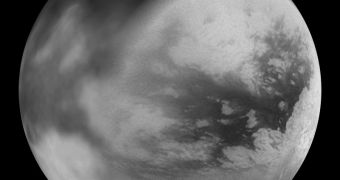Saturn's moon, Titan, has a strange atmosphere, and astronomers are very interested in finding the source of the phenomena that led to the forming of the only nitrogen-rich mix of gases in the solar system. From this point of view, the atmospheric mixture is somewhat close to that of the Earth in complexity.
Titan is 50 percent larger than our Moon in diameter, and it's even larger by diameter and mass than all known dwarf planets, like Mercury, even though the latter is more than twice as massive.
The satellite is the only known moon with a fully developed atmosphere that consists of more than just trace gases, and data transmitted by the plasma spectrometer and the other sensors aboard the Cassini spacecraft have revealed an unexpected cloud of very heavy ions 1000km above Titan's surface.
Made up of methane and nitrogen exposed to intense sunlight, the ions are complex organic molecules, mostly polycyclic aromatic hydrocarbons (PAH's) and similar compounds containing nitrogen.
Actually, they bind together to gradually form increasingly complex molecules that can reach masses of 8,000 times that of a single hydrogen atom, that fall on the surface of Titan and form compounds called "tholins," that form a tar-like layer of organic precipitate.
The fact that these organic molecules can form from inorganic materials means they could be the building blocks from which life forms. "It's humbling to think that, with our instrument at Titan, we may be seeing processes which were at work in Earth's early atmosphere and which eventually led to life on Earth. It turns out that Titan's atmosphere is an organic chemical factory on a grand scale. To see such heavy negative ions was a big surprise for us, and is a key finding linking processes in Titan's atmosphere to the surface of Titan itself - and perhaps to dark, PAH-related deposits on Saturn's other moons," said Dr Andrew Coates, from UCL Mullard Space Science Laboratory.
Some researchers have speculated that Earth may have been seeded by organic compounds early in its development by tholin-rich comets, providing the raw material necessary for life to develop.

 14 DAY TRIAL //
14 DAY TRIAL //